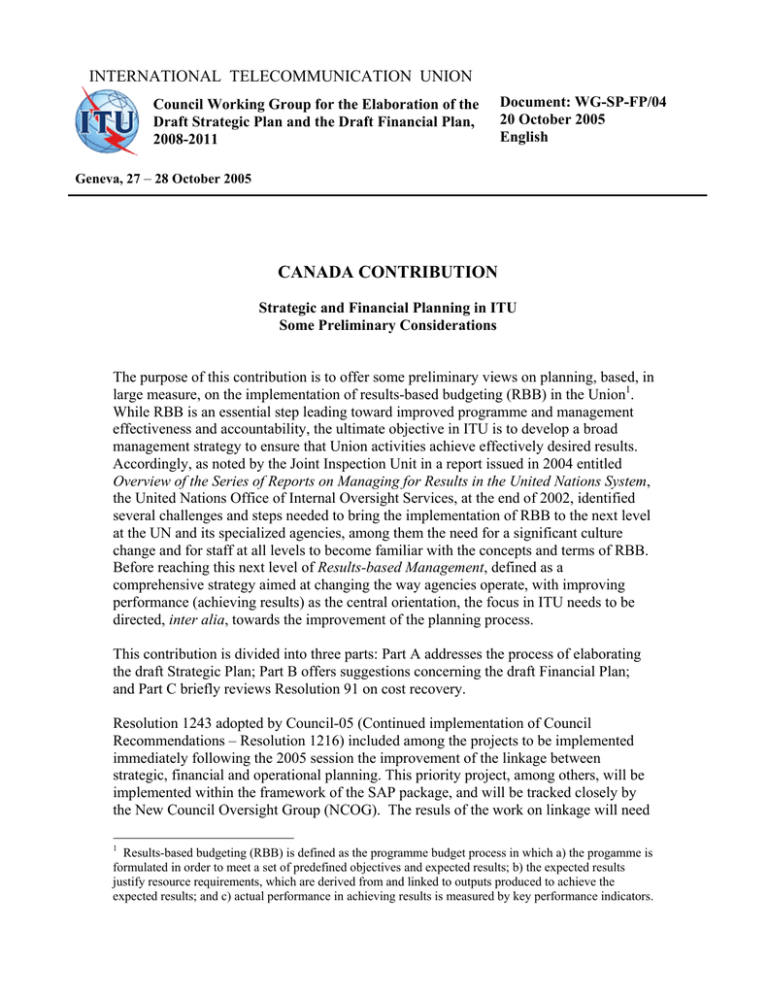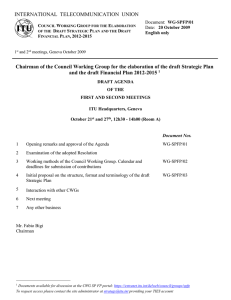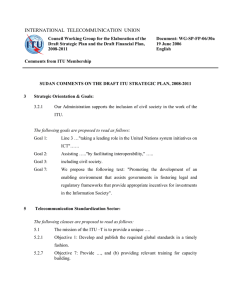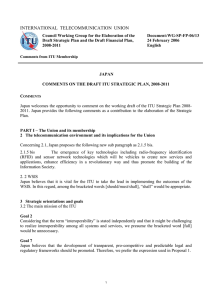INTERNATIONAL TELECOMMUNICATION UNION
advertisement

INTERNATIONAL TELECOMMUNICATION UNION Council Working Group for the Elaboration of the Draft Strategic Plan and the Draft Financial Plan, 2008-2011 Document: WG-SP-FP/04 20 October 2005 English Geneva, 27 – 28 October 2005 CANADA CONTRIBUTION Strategic and Financial Planning in ITU Some Preliminary Considerations The purpose of this contribution is to offer some preliminary views on planning, based, in large measure, on the implementation of results-based budgeting (RBB) in the Union1. While RBB is an essential step leading toward improved programme and management effectiveness and accountability, the ultimate objective in ITU is to develop a broad management strategy to ensure that Union activities achieve effectively desired results. Accordingly, as noted by the Joint Inspection Unit in a report issued in 2004 entitled Overview of the Series of Reports on Managing for Results in the United Nations System, the United Nations Office of Internal Oversight Services, at the end of 2002, identified several challenges and steps needed to bring the implementation of RBB to the next level at the UN and its specialized agencies, among them the need for a significant culture change and for staff at all levels to become familiar with the concepts and terms of RBB. Before reaching this next level of Results-based Management, defined as a comprehensive strategy aimed at changing the way agencies operate, with improving performance (achieving results) as the central orientation, the focus in ITU needs to be directed, inter alia, towards the improvement of the planning process. This contribution is divided into three parts: Part A addresses the process of elaborating the draft Strategic Plan; Part B offers suggestions concerning the draft Financial Plan; and Part C briefly reviews Resolution 91 on cost recovery. Resolution 1243 adopted by Council-05 (Continued implementation of Council Recommendations – Resolution 1216) included among the projects to be implemented immediately following the 2005 session the improvement of the linkage between strategic, financial and operational planning. This priority project, among others, will be implemented within the framework of the SAP package, and will be tracked closely by the New Council Oversight Group (NCOG). The resuls of the work on linkage will need 1 Results-based budgeting (RBB) is defined as the programme budget process in which a) the progamme is formulated in order to meet a set of predefined objectives and expected results; b) the expected results justify resource requirements, which are derived from and linked to outputs produced to achieve the expected results; and c) actual performance in achieving results is measured by key performance indicators. 2 to be factored into the overall approach adopted for the elaboration of the planning exercises. PART A: The Elaboration of the draft Strategic Plan, 2008-2011 Accompanying the introduction of the RBB approach in ITU, as outlined in the Draft Biennial Budget for the years 2006-2007 presented to the 2005 session of the Council for approval (Document C05/10), was the identification of a number of key elements that must be included in the elaboration of the draft Strategic Plan for 2008-2011. In combination these elements form the basis of a new methodology and approach to strategic planning. As was the case in previous strategic planning exercises, the content of the Strategic Plan will be derived from resolutions, decisions, plans of action, membership contributions, etc. relevant to the purposes of the Union outlined in its treaty instruments. The principal tasks of the upcoming meetings of the Sector advisory groups will be to identify the objectives and priorities of their respective Sectors based on the new methodology and approach to planning. Methodology In order to implement Resolution 72 (Rev. Marrakesh, 2002) dealing with the linkage between strategic, financial and operational planning, an integrated planning process becomes essential to ensuring successful implementation of the RBB approach. The systematic linkage between strategy (objectives) and operations (outputs to achieve the objectives) in terms of budgetary data is complementary to operational planning, which consists of a staged conversion of Sector objectives into delivered outputs and required resources. One of the key tasks of the Working Group for the Elaboration of the draft Strategic Plan and the draft Financial Plan is to develop a uniform structure and format for these planning exercises based on the results-based budgeting (RBB) framework, as outlined in its terms of reference pursuant to Council Decision 527. Definitions of the terms and concepts to be used form an essential part of the preliminary work to be undertaken by the Working Group. Part II of the current Strategic Plan annexed to Resolution 71 outlines the mission and “priorities” of the Sectors. Part III describes the mission of the Secretariat, as well as a number of “objectives”. Part IV refers to the financial base of the Union and describes “linkages” in very general terms. 3 In consideration of the foregoing, the draft Strategic Plan, insofar as it is applicable to the three Sectors2, should be elaborated as follows: Mission Taking the current descriptions of the mission statements as a point of departure, updates could be formulated on the basis of developments affecting the activities of the Sectors since the drafting of the 2004-2007 Strategic Plan. For example, for ITU-T, the World Telecommunication Standardization Assembly, held in 2004, agreed to include an additional paragraph in the description of the ITU-T mission, to reflect the text associated with paragraph 44 of the Declaration of Principles of the WSIS, as follows (see Annex 1, Document WTSA-04/94): 5.1 Standardization is one of the essential building blocks of the Information Society. There should be particular emphasis on the development and adoption of international standards. The development and use of open, interoperable, nondiscriminatory and demand-driven standards that take into account needs of users and consumers is a basic element for the development and greater diffusion of ICTs and more affordable access to them, particularly in developing countries. International standards aim to create an environment where consumers can access services worldwide regardless of underlying technology. In the case of ITU-R, ITU-D, as well as ITU-T, the Operational Plans presented to the 2005 session of the ITU Council applicable for the 2005 to 2008 period should be consulted, with a view toward reflecting any appropriate amendments to the descriptions of the respective mission statements. Objectives To illustrate how this process can be implemented, the Operational Plan for ITU-R clearly identifies five objectives, which are in turn are linked to their respective outputs. For the draft Strategic Plan, the objectives and outputs (or aggregated outputs) will need to be identified for each Sector. In addition, the objectives identified in the draft Strategic Plan for the three Sectors and for the secretariat (or General Secretariat), will need to be linked clearly with the six current or amended overall goals and orientations/overall objectives in the 2004-2007 version of the Strategic Plan. Outputs/Aggregated Outputs 2 Given the different orientation and objectives of the General Secretariat in providing, inter alia, support to ITU-R, ITU-T and ITU-D, the elements associated with the presentation of the Strategic Plan may need to be organized in a slightly different manner. 4 Outputs are defined as Sector or inter-sectoral products or services representing the deliverables of a programme. Aggregated outputs can be used to group any given number of outputs in order to simplify the presentation of the relevant data. Priorities The objectives should reflect the priorities identified in the draft Strategic Plan, and also take into consideration the priorities arising from the decisions of conferences, assemblies and applicable meetings and events taking place under the auspices of the Union. It should be recalled that, pursuant to Recommendation 3 of the Group of Specialists, “Council should direct the Directors of the Bureaux. . . .to prioritize their activities in order to enable. . . . Council to allocate the necessary budget to high priority activities.” What this implies is that the Union should endeavour to develop, within the context of the Strategic Plan, a sense of overall priority to certain activities (e.g. world radiocommunication conferences) which should not be specific to one Sector only. This also implies, as outlined in the rationale to recommendation 3, that the Sector advisory groups can play an important role in defining Sector priorities to enable the Council to set a biennial work programme within budgetary limits. However, the Council should not automatically accept activities that are approved by Sector organs. The Council has the responsibility to ensure that the highest priority activities of the Union as a whole are properly resourced. This means that it may be necessary for the Council to identify and defer certain activities. Expected Results Expected results should reflect the desired outcome of activities. They should be linked, where applicable, to the underlying objectives of the strategic plan. Expected results may be expressed as a quantitative standard, value or rate leading to the fulfilment of a certain objective. From the specification of expected results, key performance indicators can be derived in order to quantify and measure results. Key Performance Indicators (KPIs) KPIs are used to measure the achievement of expected results of objectives and subsequent targets derived from strategic and operational planning. The logical linkage between aggregated outputs, Sector objectives and overall ITU objectives provides a basis for understanding the relationship of outputs to the different goals of ITU. This is consistent with recommendation 20 of the Group of Specialists, with its emphasis, inter alia, on the need to link programmes with strategic objectives, to establish levels of spending, to evaluate the consequences of good or poor performance, to accommodate changes in the organization, to reorient some activities, and to introduce corrective actions in problematic areas. 5 Having identified objectives, outputs and priorities in the appropriate sections of the draft Strategic Plan and their linkages, the operational plans should provide, inter alia, descriptions in relation to these elements, human and financial resource allocations, the service level agreements3 (SLAs) for documentation and publications as well as the SLAs relating to the other shared services, when required, the performance report for the year in question, including the comparison between the expected and realized results, as well as the key performance indicators (KPIs), and the statement of expected results and KPIs for the applicable timeframe. Strategic Orientations and Goals/Overall Objectives The Strategic Plan of the Union for 2004-2007 in Resolution 71 (Rev. Marrakesh, 2002) sets six strategic goals that are to be achieved by undertaking priority actions and by the delivery of outputs. Outputs may contribute to one or several goals. One of the tasks of the Decision 527 Working Group will be to determine the continued validity of these overall strategic orientations and goals. The Role of Council in the New Planning Regime Pursuant to No. 87A, No. 181A, No. 205A and No. 223A of the Convention, the General Secretariat and the three Bureaux are obliged to prepare annual operational plans of activities consistent with the Strategic Plan, including financial implications, taking due account of the Financial Plan as approved by the Plenipotentiary Conference; these operational plans shall be reviewed by the advisory groups of all three Sectors, and shall be reviewed and approved annually by the Council. For practical reasons, and in the absence of a clear linkage between strategic, financial and operational planning, the 2004 and 2005 sessions of the Council did not examine the operational plans in detail, but simply endorsed them in general. In order for the Council to carry out its responsibilities to approve the operational plans, the timing of Council sessions becomes a critical consideration vis-à-vis the timing of the meetings of the advisory groups. As outlined in the Report on the Consultancy Project (Resolution 1212)4, paragraph 6.7, the following is recommended: “Our preference for a September Council is designed to leave more room during the year for integration of Sector operational planning with the overall budget cycle, and to make every attempt to reflect Sector advisory group input, not only in operational plans but, on major issues, in the budget as well. The lack of a 3 A service level agreement (SLA) is defined as a bilateral contract between a service provider and a service receiver (inside or outside the organization). The objective of an internal SLA is to optimize the type and quality of internal services and to ensure that they are adapted to real needs and to the achievement of objectives. An SLA template describes the service concerned in terms of business expectations, such as planned volume and price, which may be the subject of a negotiation process between the two parties, and of the service characteristics (service components, expected results, related to key performance indicators, etc.). 4 Document C04/42. 6 systematic connection between the input of Sector and ITU-wide membership groups is a fundamental weakness in the current planning and budgeting process.” What this clearly suggests is that the timing of meetings in the future will form a critical part of the enhancement and improvement of planning in ITU. In practical terms, once consensus is reached on the scheduling of the annual meetings of the Council, it will be incumbent on the Sectors to programme the meetings of the advisory bodies to complement the consideration of planning matters by the Council. It is proposed that this matter be reviewed by the Working Group on the Elaboration of the draft Strategic and Financial Plans for decision by PP-06. PART B: Elaboration of the Draft Financial Plan, 2008-2011 The overall programme framework and programme goals and priorities applied in the Financial Plan are to be based on the draft Strategic Plan for 2008-2011. In accordance with Article 10, No. 70 of the Constitution, the Council is responsible for preparing a report on the policy and strategic planning recommended for the Union, together with their financial implications. In order to comply both with this requirement and to provide the Plenipotentiary Conference with the tools necessary to determine the basis for a revision to Decision 5 (Income and expenditure of the Union for the period 2008 to 2011) in terms of the value of the contributory unit, and to Decision 6 representing the Financial Plan itself, projected figures based on income and expenditure estimates calculated to represent zero nominal growth (ZNG), zero real growth (ZRG), a decrease of 1% and an increase of 1%, would be useful for comparative purposes. Moreover, in order to provide a clear linkage between strategic and financial planning, a set of basic principles should be enunciated, which provides a framework for decisionmaking at PP-06. Among the key considerations is the anticipated limitations on both human and financial resources, which places a premium on identifying sectoral and intersectoral priorities as part of the strategic planning process. Such resource limitations, which will need to be examined thoroughly in relation to the WSIS outcomes, place a premium on the ITU and its membership to identify the key and essential activities of the Union in the next plenipotentiary period.5 As noted in the above descriptions of the elements associated with both strategic and operational planning, priorities are derived in part in the decisions that are taken by major ITU events such as conferences and assemblies. There are circumstances, however, where resource limitations may require the deferment of certain activities pending the availability of additional resources. In these cases, when the draft Financial Plan is considered by the 2006 Plenipotentiary Conference, the use of the concept of “unfunded mandated activities” (UMACs) may be useful to denote activities and/or support activities that could be carried out pending the availability of sufficient funds. The 5 Pursuant to Council-05 Resolution 1244 (ITU role in the Tunis Phase of WSIS and in implementation and follow-up), emphasis is placed on ensuring that the definition of the possible ITU role vis-à-vis the WSIS outcomes is consistent with the core competencies of the Union. 7 category of “UMACs” was included in the draft Financial Plan presented to the 2002 Plenipotentiary Conference to reflect a difficult financial situation in the Union, which has not changed substantially. In the absence of consensus on the activities and/or support activities to be included as “UMACs”, however, other strategies will need to be identified in order to achieve the overall objective of the Financial Plan to balance income and expenditure. PART C: Review of Resolution 91 (Minneapolis, 1998) (Cost recovery for some ITU products and services) As noted in Council Decision 527, among the terms of reference of the Working Group for the Elaboration of the Draft Strategic Plan and the Draft Financial Plan, 2008-2011, is the review of Resolution 91 to determine whether any amendments or updates are required in light of the application of cost recovery to a variety of ITU products and services since its adoption by the 1998 Plenipotentiary Conference. In this regard, attention may need to be focused on a) the philosophy and purpose of cost recovery within the overall financial framework of ITU, b) which activities (products and services) should be continued and/or considered as possible candidates for cost recovery, and c) the continued validity of such concepts as “revenue generation” and “actual costs” in this context.



